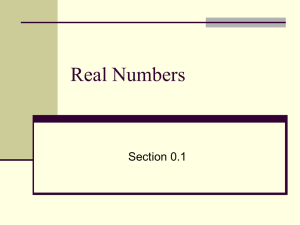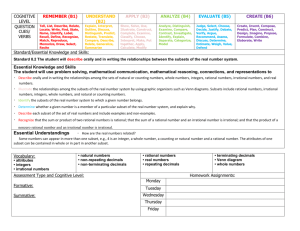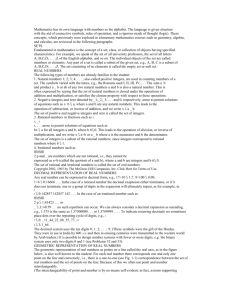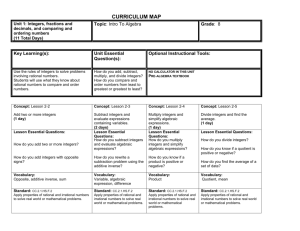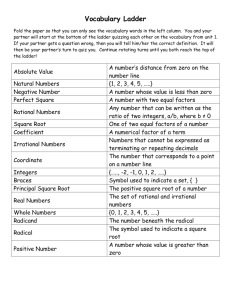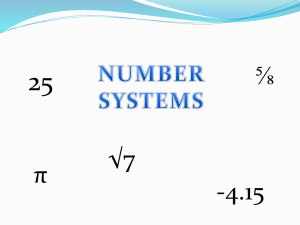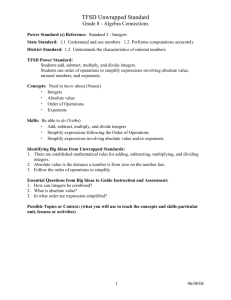Number Systems 2
advertisement
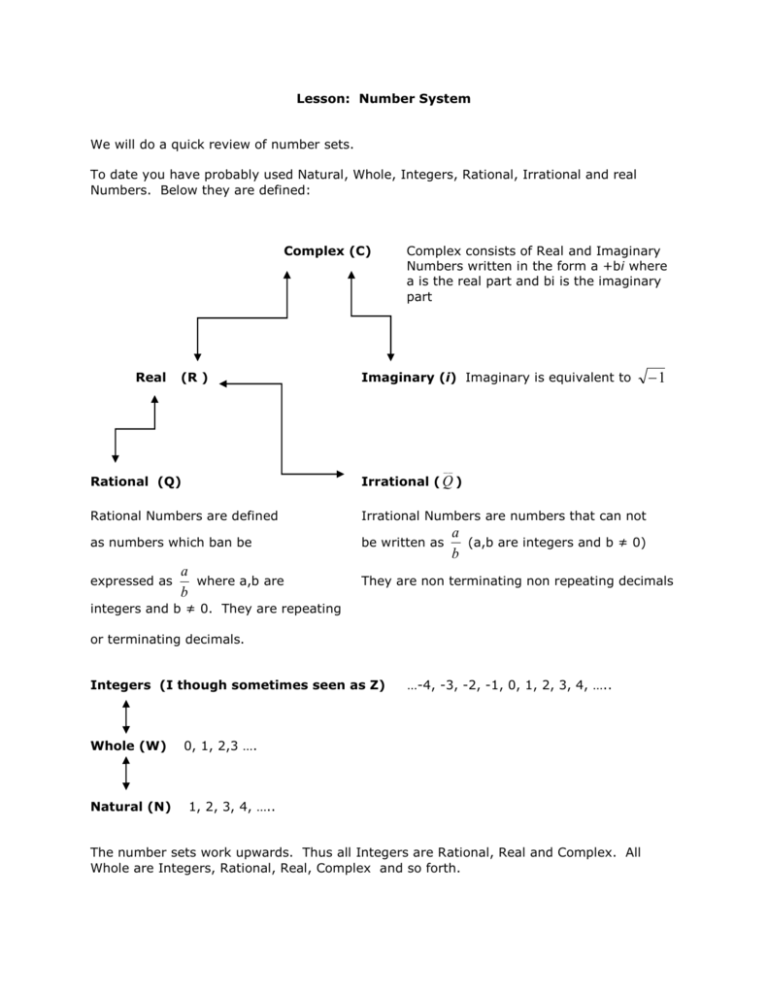
Lesson: Number System
We will do a quick review of number sets.
To date you have probably used Natural, Whole, Integers, Rational, Irrational and real
Numbers. Below they are defined:
Complex (C)
Real
(R )
Complex consists of Real and Imaginary
Numbers written in the form a +bi where
a is the real part and bi is the imaginary
part
Imaginary (i) Imaginary is equivalent to
__
Rational (Q)
Irrational ( Q )
Rational Numbers are defined
Irrational Numbers are numbers that can not
as numbers which ban be
be written as
expressed as
a
where a,b are
b
a
(a,b are integers and b ≠ 0)
b
They are non terminating non repeating decimals
integers and b ≠ 0. They are repeating
or terminating decimals.
Integers (I though sometimes seen as Z)
Whole (W)
Natural (N)
1
…-4, -3, -2, -1, 0, 1, 2, 3, 4, …..
0, 1, 2,3 ….
1, 2, 3, 4, …..
The number sets work upwards. Thus all Integers are Rational, Real and Complex. All
Whole are Integers, Rational, Real, Complex and so forth.
It sometimes can be viewed using the following diagrams
N
Q
W
I
Q
R
Example:
Check off the number set to which each number belongs
N
W
I
Q
__
Q
X
R
C
X
X
X
X
X
X
0.6
X
2
X
-4
X
Functions
A function is a rule that assigns to each element ‘x’ exactly one element ‘y’.
We can test for functions by seeing
-
if every a value has a unique y value
the graph passes the vertical line test
Example:
Determine if the following are functions
No … can draw a straight
vertical line through the graph
and touch more than one part
of the graph
No … can draw a straight
vertical line through the graph
and touch more than one part
of the graph
Yes … you can draw a vertical
line through any part
of the graph and only touch
one part of the graph
Example:
Determine if the following are functions
{(3, 3), (4, 4), (4, 6), (6, 7)}
{(2, 1), (2, 3), (4, 5)}
NO .. since x = 4 has two y values not 1 unique y value
No .. since x = 2 has two y values not 1 unique y value
Example:
Is y = 2x – 3 a function?
To determine this, we must get an idea of what
the graph looks like and see if it passes the vertical
line test
So, on eth right, if we look at the graph, we clearly see
it passes the vertical line test and indeed is a function!!
Example:
Is y = x2 a function?
In order to plot, we need a table of values
x
-2
-1
0
1
2
y = x2
4
1
0
2
4
So YES A FUNCTION since it passes the vertical line test!!
Relations
A relation R, is a set of ordered pairs. The same relation can be represented in many
different ways as seen below.
Table of values
x
0
1
2
3
4
5
6
A graph
y
0
1
4
9
16
25
36
Set of ord’ pairs
{(0,0)(1,1)(2,4)(3,9)(4,16)(5,25)(6,36)}
Equation
y = x2 for { x I, 0 x 6}
DOMAIN: The domain of R is set of first co-ordinates of the ordered pairs. It is the set of
ALL x values for which the equation is defined.
RANGE: The range of R is set of 2nd co-ordinate of the ordered pairs. It is the set of ALL y
values for which the equation is defined.
Domain
Range
Formal Notation
We use to use ‘y =’ notation for graphing. But what happens when we have more than one
variable in the equation??
If we have y = 2a + 2x …. How do we know what to substitute into when evaluating the
equation?
Before we would write y = 2a + 2x and then say solve for ‘y’ when x = 3
Then we would write y = 2a +2 (3)
thus
We can now refer to ‘y’ as f(x) and it is said
y = 2a + 6
f of x.
f(x) = 2a + 2x
This means, it is a function of x. This means when we substitute values in, we substitute
them into x.
f(a) = 2a + 2x means when we substitute values in, we substitute them into a since it is a
function of a.
Example:
If f(x) = 3x – 1, find f(5).
This means, wherever you see x, you replace it with 5
f(x) = 3x – 1
f(5) = 3(5) – 1
f(5) = 14
So this is your answers!!
Example:
If h(t) = t2 + 3 find h(4)
h(4) means to use h(t) = t2 + 3
plug in 4 wherever you see a ‘t’
h(t) = t2 + 3
h(4) = 42 + 3
h(4) = 16 + 3
h(4) = 19
Example:
If f(x) = 4x – 5 find f(-3)
f(-3) means to use f(x) = 4x - 5
plug in -3 wherever you see an ‘x’
f(x) = 4x – 5
f(-3) = 4(-3) – 5
f(-3) = -12 – 5
f(-3) = -17
Example:
1. If h(x) = 3x + 4 and f(x) = 2x – 3 find h(5) and f(-3)
h(5) = 3(5) + 4 = 19
f(-3) = 2(-3) - 3 = -9
2. If f(x) = 3x + 4 find:
a. f(a)
b. f(b)
c. f(a) + f(b)
d. f(a +b)
e. Does f(a) + f(b) = f(a +b)
a. f(a) = 3a + 4
b. f(b) = 3b + 4
c. f(a) + f(b) = 3a + 4 + 3b + 4 = 3a + 3b + 8
d. f(a + b) = 3(a + b) + 4 = 3a + 3b + 4
Thus 3a + 3b + 8 ≠ 3a + 3b + 4
so f(a) + f(b) ≠ f(a +b)
3. If g(t) = 3t – 1 find:
a. g(2t)
b. g(1/3)
c. g(t – 1)
a. g(2t) = 3(2t) – 1 = 6t - 1
b. g(1/3) = 3(1/3) – 1 = 1 – 1 = 0
c. g(t – 1) = 3(t – 1) – 1 = 3t – 3 – 1 = 3t – 4
4. If g(t) is represented on the graph to the right
find g(2)
g(2) means to find the ‘y’ value when t = 2
At t = 2, the y value is 0
This g(2) = 0
If I said find g(t) when x = 1, you would look at x = 1 and find the value is -1
5. If f(x) = 4x -1 find x so f(x) = 5
This means you let f(x) = 5 and solve for x
f(x) = 4x -1
5 = 4x – 1
6 = 4x
x = 3/2



